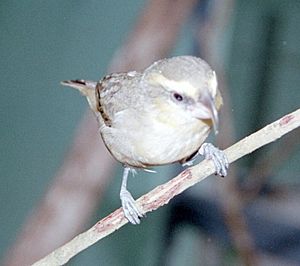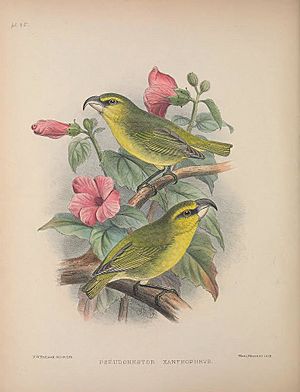Maui parrotbill facts for kids
Quick facts for kids Maui parrotbill |
|
|---|---|
 |
|
| Conservation status | |
| Scientific classification | |
| Genus: |
Pseudonestor
|
| Species: |
xanthophrys
|
The Maui parrotbill or kiwikiu (Pseudonestor xanthophrys) is a special type of Hawaiian honeycreeper. It lives only on the island of Maui in Hawaii. You can find it in about 50 square kilometers (19 square miles) of wet and moist forests. These forests are high up on the slopes of Haleakalā, between 1,200 and 2,150 meters (3,900–7,050 feet) high. This bird is in great danger of disappearing forever. There are only about 500 of them left. Long ago, these birds also lived in drier forests and on the island of Molokaʻi.
Contents
Meet the Maui Parrotbill
The Maui parrotbill is one of the larger Hawaiian honeycreepers. It is about 14 centimeters (5.5 inches) long and weighs 20 to 25 grams (0.7 to 0.9 ounces). Its chest, cheeks, and belly are yellow. Its wings, head, tail, and back are olive-green. It has a bright yellow stripe above its eye.
The bird's beak is very special. The top part is hooked and dark gray. The bottom part looks like a chisel and is pale ivory. Male parrotbills are a bit bigger than females. They have longer wings and bigger beaks. Young birds are gray-green on top and light gray underneath.
What Does It Sound Like?
The Maui parrotbill makes a short "chip" sound. It chirps every three to five seconds. This sound is a bit like the Maui Nui ʻalauahio bird. Its song has "cheer" notes that are slower and richer than the ʻākepa bird's song. It also has a short song that sounds like "cheer-wee."
What Does the Maui Parrotbill Eat?
The Maui parrotbill mostly eats insects. It uses its strong beak and powerful jaw muscles to pull off bark and wood from small trees and shrubs. It looks for insects hiding underneath. Some of its favorite plants to search on are ʻākala (a type of raspberry), kanawao, and ʻōhiʻa lehua trees.
This bird also bites open fruits to find insects inside. It especially likes moth pupae and beetle larvae. A pair of parrotbills will search for food in an area about 2.3 hectares (5.7 acres) big. They must protect this area from other parrotbills.
Reproduction and Family Life
Maui parrotbills stay with one partner for life. They have their babies between November and June. The female bird builds a cup-shaped nest. She uses Usnea lichens and pūkiawe twigs. The nest is usually about 12 meters (39 feet) high in a tree.
A pair of birds usually raises only one baby each season. The female sits on the egg for 16 days to keep it warm. Once the baby bird can fly, it stays with its parents for five to eight months. During this time, it learns how to find food on its own.
Where Does the Maui Parrotbill Live?
The Maui parrotbill now lives only in quiet, untouched wet forests. These forests are mostly filled with ʻōhiʻa lehua trees. There are also some smaller areas of ʻōhiʻa-koa forests.
Its home has many small trees, shrubs, epiphytes (plants that grow on other plants), ferns, and sedges. This special area is less than 2,020 hectares (5,000 acres) big. It is located between Puʻu ʻAlaea, Kuhiwa Valley, Lake Waianapanapa, and upper Kīpahulu Valley. The birds live at elevations between 1,310 and 2,070 meters (4,300–6,790 feet).
The Hawaiian Name Kiwikiu
For a long time, the Maui parrotbill did not have a Hawaiian name. The Hawaiian Lexicon Committee created the name kiwikiu. The Maui Forest Bird Recovery Project asked them to choose a good name. A special ceremony was held in the bird's home in September 2010.
The "kiwi" part of the name means bent or curved. This describes the unique shape of the bird's beak. "Kiu" has two meanings. It refers to how secretive the bird is. It also means a cold, chilly wind, like the breezes in the bird's mountain home.
Protecting the Maui Parrotbill
The Maui parrotbill's natural home is in wet and moist forests. But its home is being destroyed. A lot of the land where these birds used to live was changed for farms, cutting down trees, and animal grazing.
New problems have also arrived, like mosquitoes, rats, and wild pigs. These animals hurt the parrotbill directly and indirectly. Mosquitoes spread a bird disease called avian malaria, which the parrotbill can get. Rats eat the birds' eggs and young chicks. Wild pigs dig up the plants where the parrotbill looks for food. Pigs also create muddy holes, which are perfect places for mosquitoes to lay eggs.
The Maui parrotbill was listed as an endangered species in 1967. This means it is protected by law. In 1984, a plan was made to help birds on Maui and Molokai. This plan led to putting fences around areas in East Maui and removing wild pigs. The plan also included a program to breed the birds in captivity. The first baby bird from this program was born in 2003. The Maui Forest Bird Recovery Project does most of the research in the wild.
A study in 2009 found about 20 Maui parrotbills per square kilometer in the Waikamoi Preserve. This suggests that the number of birds might be staying the same or even growing. One reason for this is that native shrubs in Waikamoi have grown a lot in the last 15 years. This preserve is home to about 25 percent of all Maui parrotbills. Most of the other birds live in the Hanawi Natural Area Reserve. These birds used to live all over Maui and Molokai.
See also
 In Spanish: Pseudonestor xanthophrys para niños
In Spanish: Pseudonestor xanthophrys para niños



